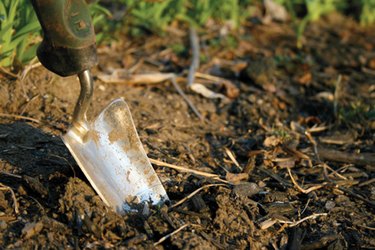
Whether you want to cultivate a lush backyard garden or construct an addition to your home, soil compaction is an important factor that dictates the success of many projects around the home and garden. Most testing methods measure density and effects of moisture on the soil, the two primary variables that influence soil compaction. You can test soil compaction levels by many different methods ranging from simple tactile estimates at home, to expensive professional laboratory analysis.
Hand Test
Video of the Day
The hand test is the oldest means of measuring soil compaction and requires no special equipment. Simply grab a handful of soil you want to test and squeeze it into a ball. If the soil crumbles apart into many pieces and will not reform when you squeeze it again, then the soil is uncompacted and dry. Soil that breaks apart into a few large chunks that easily reform when you squeeze them is a sign of uncompacted soil with a good amount of moisture. Compacted soils will not break apart in your hand, but are malleable and plastic-like in their consistency when moist; then are hard and unbreakable by hand when dry.
Video of the Day
Proctor Test
The Proctor test was developed by engineer Richard Procter as a means of testing the compaction potential of soils, an important variable for many construction projects. The test gives two important results: the maximum density of the soil and the effects of moisture on soil density. The Proctor test procedure requires that three different layers of soil are placed into a cylindrical tube in sequence. A standardized weight is dropped onto the soil repeatedly and the results are measured. The sample then dries overnight and is weighed in order to measure the moisture content. The results of the Proctor test can help engineers decide on how much soil compaction is needed for a project and what type of application will best achieve the needed soil conditions.
The Nuclear Density Gauge
The nuclear density gauge is a small device that can be transported between testing sights. It operates by measuring the occurrence of a radioactive isotope in the soil in one of two ways. Either by generating small doses of gamma rays that hit the soil surface and then measuring the backscatter--reflection--of the radiation, or by inserting a probe into the soil which transmits the gamma rays directly. Dense, compacted soils absorb more radiation than uncompacted soils. Nuclear density gauges are an expensive, but accurate, timely and effective means of measuring soil compaction.
- Concrete Catalog: Soil Compaction Handbook
- Colorado State University Extension: Estimating Soil Texture
- Humboldt: Nuclear Density Gauge
- Giles Engineering Associates: Soil Compaction and Stability
- American Society for Testing and Materials: Standards: Standard Test Methods for Laboratory Compaction
- EPA: Evaluation of Soil Compaction Measuring Devices